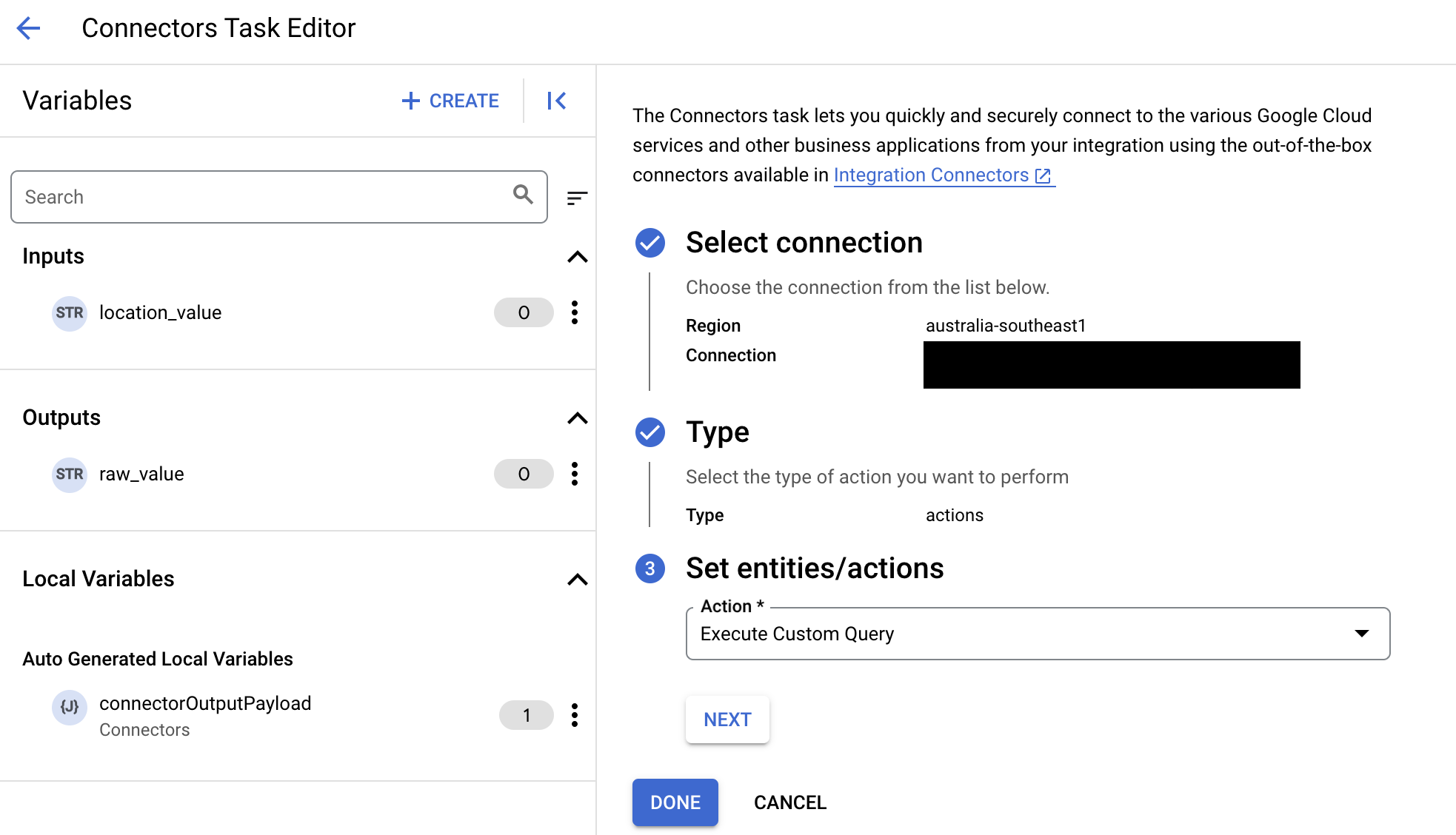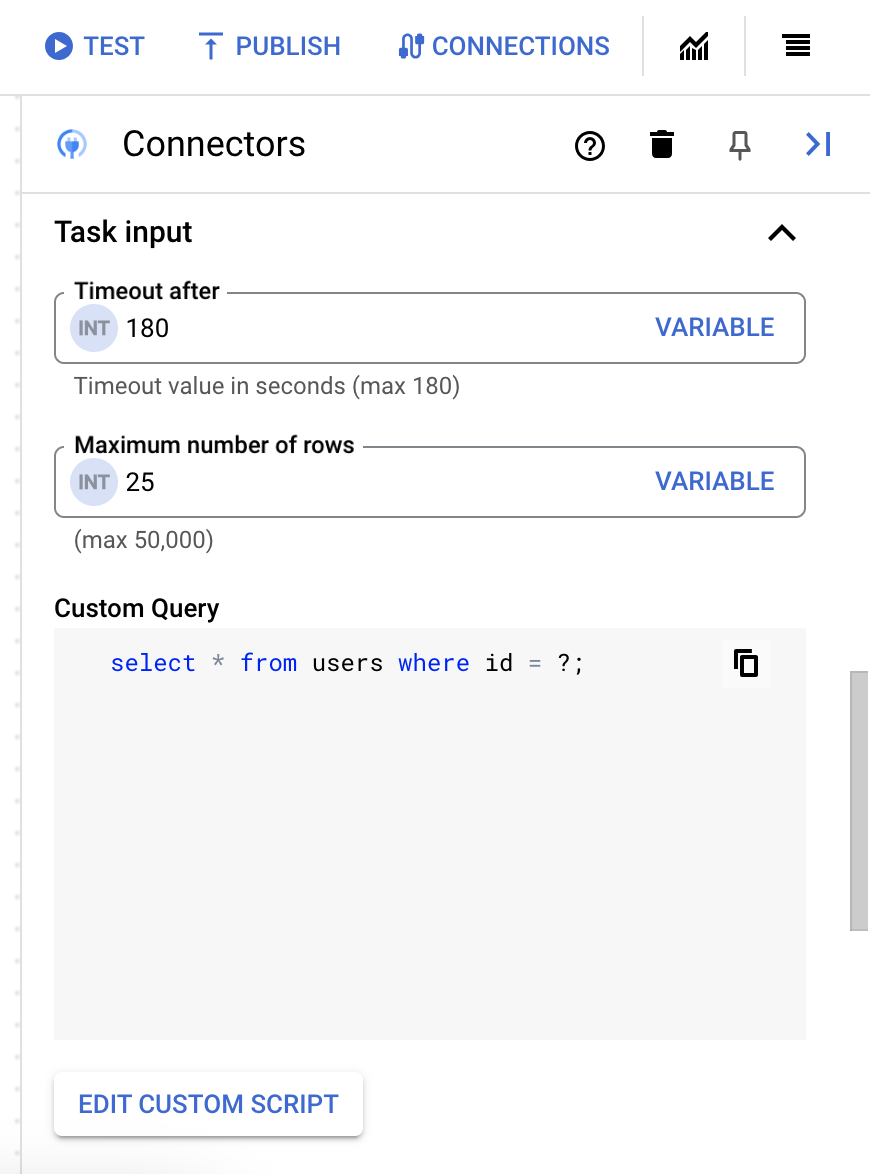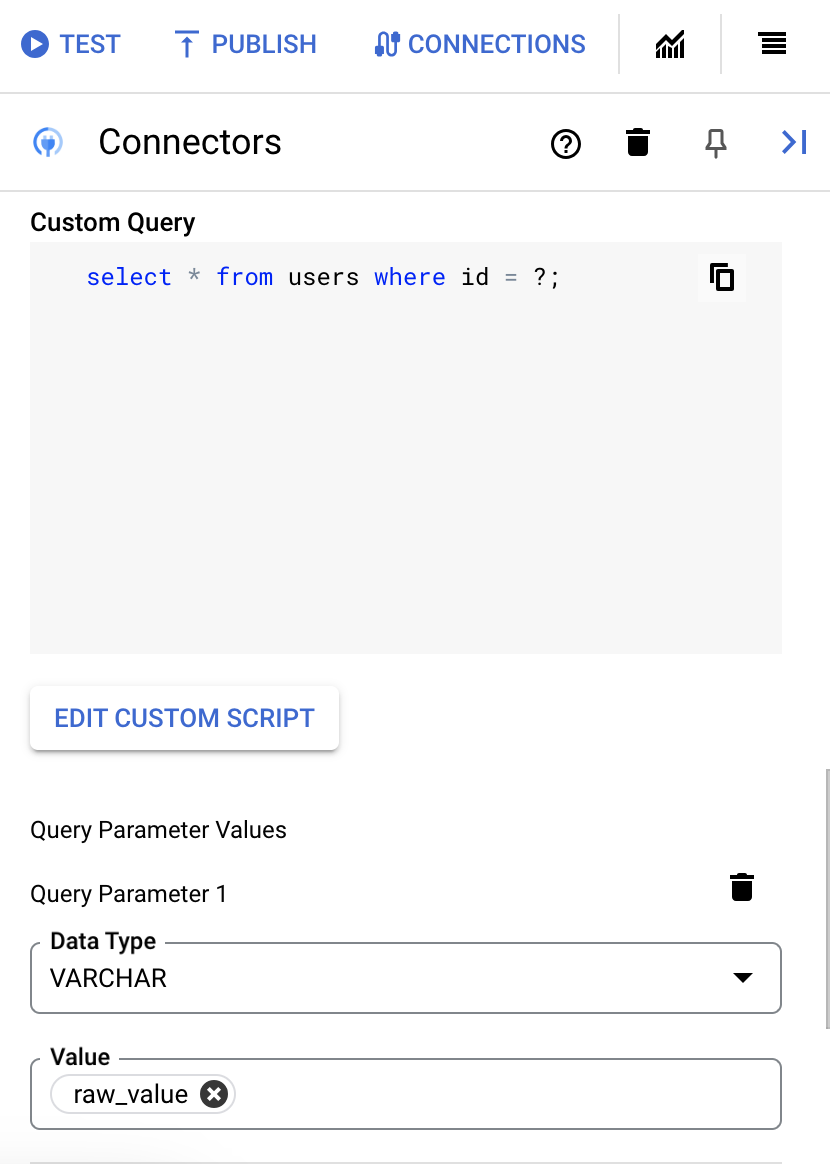Greenplum
Supported versions
Greenplum versions 6.27.1 and later
Before you begin
Before using the Greenplum connector, do the following tasks:
- In your Google Cloud project:
- Ensure that network connectivity is set up. For information about network patterns, see Network connectivity.
- Grant the roles/connectors.admin IAM role to the user configuring the connector.
- Grant the following IAM roles to the service account that you want to use for the connector:
roles/secretmanager.viewerroles/secretmanager.secretAccessor
A service account is a special type of Google account intended to represent a non-human user that needs to authenticate and be authorized to access data in Google APIs. If you don't have a service account, you must create a service account. For more information, see Creating a service account.
- Enable the following services:
secretmanager.googleapis.com(Secret Manager API)connectors.googleapis.com(Connectors API)
To understand how to enable services, see Enabling services.
If these services or permissions have not been enabled for your project previously, you are prompted to enable them when configuring the connector.
Configure the connector
A connection is specific to a data source. It means that if you have many data sources, you must create a separate connection for each data source. To create a connection, do the following:
- In the Cloud console, go to the Integration Connectors > Connections page and then select or create a Google Cloud project.
- Click + Create new to open the Create Connection page.
- In the Location section, choose the location for the connection.
- Region: Select a location from the drop-down list.
For the list of all the supported regions, see Locations.
- Click NEXT.
- Region: Select a location from the drop-down list.
- In the Connection Details section, complete the following:
- Connector: Select Greenplum from the drop down list of available Connectors.
- Connector version: Select the Connector version from the drop down list of available versions.
- In the Connection Name field, enter a name for the Connection instance.
Connection names must meet the following criteria:
- Connection names can use letters, numbers, or hyphens.
- Letters must be lower-case.
- Connection names must begin with a letter and end with a letter or number.
- Connection names cannot exceed 49 characters.
- Optionally, enter a Description for the connection instance.
- Optionally, enable Cloud logging,
and then select a log level. By default, the log level is set to
Error. - Service Account: Select a service account that has the required roles.
- Optionally, configure the Connection node settings:
- Minimum number of nodes: Enter the minimum number of connection nodes.
- Maximum number of nodes: Enter the maximum number of connection nodes.
A node is a unit (or replica) of a connection that processes transactions. More nodes are required to process more transactions for a connection and conversely, fewer nodes are required to process fewer transactions. To understand how the nodes affect your connector pricing, see Pricing for connection nodes. If you don't enter any values, by default the minimum nodes are set to 2 (for better availability) and the maximum nodes are set to 50.
- Database: The name of the Greenplum database.
- Browsable Schemas: This property restricts the schemas reported to a subset of the available schemas. For example, BrowsableSchemas=SchemaA,SchemaB,SchemaC.
- Optionally, click + ADD LABEL to add a label to the Connection in the form of a key/value pair.
- Optionally, if you want to use SSL, select Enable SSL. This displays the SSL configuration details.
- Select a trust store type. It can be either Public, Private, or Insecure Connection.
- Select the certificates as displayed based on your trust store selection.
- If you are using mTLS, select the key store certificates in the Key Store section.
- Click NEXT.
- In the Destinations section, enter details of the remote host (backend system) you want to connect to.
- Destination Type: Select a Destination Type.
- Select Host address from the list to specify the hostname or IP address of the destination.
- If you want to establish a private connection to your backend systems, select Endpoint attachment from the list, and then select the required endpoint attachment from the Endpoint Attachment list.
If you want to establish a public connection to your backend systems with additional security, you can consider configuring static outbound IP addresses for your connections, and then configure your firewall rules to allowlist only the specific static IP addresses.
- Click NEXT.
- Destination Type: Select a Destination Type.
-
In the Authentication section, enter the authentication details.
- Select an Authentication type and enter the relevant details.
The following authentication types are supported by the Greenplum connection:
- Username and password
- Click NEXT.
To understand how to configure these authentication types, see Configure authentication.
- Select an Authentication type and enter the relevant details.
- Review: Review your connection and authentication details.
- Click Create.
Configure authentication
Enter the details based on the authentication you want to use.
-
Username and password
- Username: The Greenplum username to use for the connection.
- Password: Secret Manager Secret containing the password associated with the Greenplum username.
Supported cipher suites
| TLS version | Supported cipher suites |
|---|---|
| 1.2 |
|
| 1.3 |
|
Entities, operations, and actions
All the Integration Connectors provide a layer of abstraction for the objects of the connected application. You can access an application's objects only through this abstraction. The abstraction is exposed to you as entities, operations, and actions.
- Entity: An entity can be thought of as an object, or a collection of properties, in the
connected application or service. The definition of an entity differs from a connector to a
connector. For example, in a database connector, tables are the entities, in a
file server connector, folders are the entities, and in a messaging system connector,
queues are the entities.
However, it is possible that a connector doesn't support or have any entities, in which case the
Entitieslist will be empty. - Operation: An operation is the activity that you can perform on an entity. You can perform
any of the following operations on an entity:
Selecting an entity from the available list, generates a list of operations available for the entity. For a detailed description of the operations, see the Connectors task's entity operations. However, if a connector doesn't support any of the entity operations, such unsupported operations aren't listed in the
Operationslist. - Action: An action is a first class function that is made available to the integration
through the connector interface. An action lets you make changes to an entity or entities, and
vary from connector to connector. Normally, an action will have some input parameters, and an output
parameter. However, it is possible
that a connector doesn't support any action, in which case the
Actionslist will be empty.
System limitations
The Greeenplum connector can process 20 transaction per second, per node, and throttles any transactions beyond this limit. By default, Integration Connectors allocates 2 nodes (for better availability) for a connection.
For information on the limits applicable to Integration Connectors, see Limits.
Supported data types
The following are the supported data types for this connector:
- BIGINT
- BIGSERIAL
- BIT
- BOOLEAN
- BOX
- BYTEA
- CHARACTER
- CIDR
- CIRCLE
- DATE
- DECIMAL
- DOUBLE PRECISION
- INET
- INTEGER
- INTERVAL [FIELDS] [(P)]
- JSON
- JSONB
- LSEG
- MACADDR
- MACADDR8
- MONEY
- PATH
- POINT
- POLYGON
- REAL
- SERIAL
- SMALLINT
- TEXT
- TIME
- TIMESTAMP
- UUID
- XML
- TXID_SNAPSHOT
Actions
This connector supports execution of the following actions:
- User-defined stored procedures and functions. If you have any stored procedures and functions in your backend, those are listed
in the
Actionscolumn of theConfigure connector taskdialog. - Custom SQL queries. To execute custom SQL queries, the connector provides the Execute custom query action.
To create a custom query, follow these steps:
- Follow the detailed instructions to add a connectors task.
- When you configure the connector task, in the type of action you want to perform, select Actions.
- In the Action list, select Execute custom query, and then click Done.


- Expand the Task input section, and then do the following:
- In the Timeout after field, enter the number of seconds to wait till the query executes.
Default value:
180seconds. - In the Maximum number of rows field, enter the maximum number of rows to be returned from the database.
Default value:
25. - To update the custom query, click Edit Custom Script. The Script editor dialog opens.


- In the Script editor dialog, enter the SQL query and click Save.
You can use a question mark (?) in a SQL statement to represent a single parameter that must be specified in the query parameters list. For example, the following SQL query selects all rows from the
Employeestable that matches the values specified for theLastNamecolumn:SELECT * FROM Employees where LastName=?
- If you've used question marks in your SQL query, you must add the parameter by clicking + Add Parameter Name for each question mark. While executing the integration, these parameters replace the question marks (?) in the SQL query sequentially. For example, if you have added three question marks (?), then you must add three parameters in order of sequence.


To add query parameters, do the following:
- From the Type list, select the data type of the parameter.
- In the Value field, enter the value of the parameter.
- To add multiple parameters, click + Add Query Parameter.
- In the Timeout after field, enter the number of seconds to wait till the query executes.
Action examples
Example - Find the greater value
This example shows how to execute a user-defined function. The find_greater
function in this example, compares two integers and returns the integer which is greater.
- In the
Configure connector taskdialog, clickActions. - Select the
find_greateraction, and then click Done. - In the Task Input section of the Connectors task, click
connectorInputPayloadand then enter a value similar to the following in theDefault Valuefield:{ "$1": 1.0, "$2": 5.0 }
If the action execution is successful, the connector task's connectorOutputPayload
field will have a value similar to the following:
[{ "bignum": 5.0 }]
Entity operation examples
Example - List records of an entity
This example lists the records of the Users entity.
- In the
Configure connector taskdialog, clickEntities. - Select
Usersfrom theEntitylist. - Select the
Listoperation, and then click Done. - In the Task Input section of the Connectors task, you can set the
filterClause as per your requirement.
For example, setting the filter clause to
employeeCode='5100' and startDate='2010-01-01 00:00:00', lists only those records whose employeeCode is 5100 and startDate is 2010-01-01 00:00:00.
Example - Get a single record from an entity
This example fetches a record from the Users entity.
- In the
Configure connector taskdialog, clickEntities. - Select
Userfrom theEntitylist. - Select the
Getoperation, and then click Done. - In the Task Input section of the Connectors task, click entityId and
then enter
103032in the Default Value field.Here,
103032is the primary key value of theUsersentity.
Example - Delete a record from an entity
This example deletes a record from the Users entity.
- In the
Configure connector taskdialog, clickEntities. - Select
Usersfrom theEntitylist. - Select the
Deleteoperation, and then click Done. - In the Task Input section of the Connectors task, click entityId and
then enter
113132in the Default Value field.Alternately, if the entity has composite primary keys instead of specifying the entityId, you can set the filterClause. For example,
employeeCode='5100' and startDate='2010-01-01 00:00:00'.
Example - Create a record in an entity
This example creates a record in the Users entity.
- In the
Configure connector taskdialog, clickEntities. - Select
Usersfrom theEntitylist. - Select the
Createoperation, and then click Done. - In the Task Input section of the Connectors task, click
connectorInputPayloadand then enter a value similar to the following in theDefault Valuefield:{ "employeeCode": "5100", "startDate": "2010-01-01 00:00:00.0", "country": "US" }
If the integration is successful, the connector task's connectorOutputPayload field will
have the response of the create operation.
Example - Update a record in an entity
This example updates a record in the Users entity.
- In the
Configure connector taskdialog, clickEntities. - Select
Usersfrom theEntitylist. - Select the
Updateoperation, and then click Done. - In the Task Input section of the Connectors task, click
connectorInputPayloadand then enter a value similar to the following in theDefault Valuefield:{ "country": "IN" }
- In the Task Input section of the Connectors task, click entityId and
then enter
113132in the Default Value field.Alternately, if the entity has composite primary keys instead of specifying the entityId, you can set the filterClause. For example,
employeeCode='5100' and startDate='2010-01-01 00:00:00'.
If the integration is successful, the connector task's connectorOutputPayload field will
have the response of the update operation.
Use terraform to create connections
You can use the Terraform resource to create a new connection.To learn how to apply or remove a Terraform configuration, see Basic Terraform commands.
To view a sample terraform template for connection creation, see sample template.
When creating this connection by using Terraform, you must set the following variables in your Terraform configuration file:
| Parameter name | Data type | Required | Description |
|---|---|---|---|
| database | STRING | True | The name of the Greenplum database. |
| use_ssl | BOOLEAN | False | This field sets whether SSL is enabled. |
Use the Greenplum connection in an integration
After you create the connection, it becomes available in both Apigee Integration and Application Integration. You can use the connection in an integration through the Connectors task.
- To understand how to create and use the Connectors task in Apigee Integration, see Connectors task.
- To understand how to create and use the Connectors task in Application Integration, see Connectors task.
Get help from the Google Cloud community
You can post your questions and discuss this connector in the Google Cloud community at Cloud Forums.What's next
- Understand how to suspend and resume a connection.
- Understand how to monitor connector usage.
- Understand how to view connector logs.
